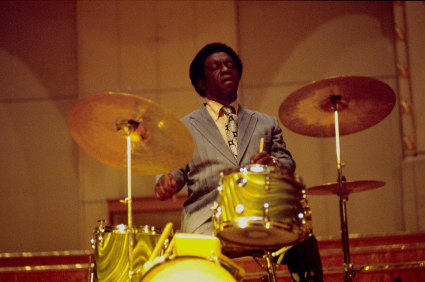.
.
photo Heinrich Klaffs/CC-BY SA 2.0/Wikimedia Commons

Art Blakey, 1973
.
.
Art School
-Jazz is known all over the world as an
American musical art form and that’s it.
No American, no jazz. I’ve seen people
try to connect it to other countries, for
instance to Africa, but it doesn’t have
a damn thing to do with Africa.
-Art Blakey
.
The Jazz Messengers were a jazz combo that existed
for over thirty-five years beginning in the early 1950s
as a collective, and ending when long-time leader
and founding drummer Art Blakey died in 1990.
Blakey led or co-led the group from the outset.
“Art Blakey” and “Jazz Messengers” became
synonymous over the years. –Wikipedia
.
Four-hundred-plus albums were released from Art School.
Sonny Rollins and Sonny Stitt came from Art School.
Fertile breeding ground – even Thelonious went.
More than 200 cats were alum from Art School.
Art was foster son of Seventh Day Adventists.
He played piano long before drums from Art’s School.
But there’s that recurring and terrifying tale
of Bu, a gun, the need for freedom from Art School.
In Pittsburgh the Democratic Club’s owner threw
Bu off piano! Said, You play drums from Art School.
Art’s being usurped from piano was a gift.
Erroll Garner played keyboard. No bums from Art School.
This disappointment for Art became a blessing,
launching stars over sixty-years firm from Art School.
Snare was spouse of the cymbal and Art was best man.
Sticks escorted pedal – jazz was birthed from Art School.
Terence Blanchard became Wynton’s understudy,
and Percy Heath hugged that huge ax, strummed for Art School.
Does each line whisper to you, “You need to to cut it.”
I thought not. Play them scales. No glumness from Art School.
Still need a trumpet player? You got Lee Morgan.
Curly Russell, Paul Chambers – bass – played from Art School.
The University of Art Blakey was huge.
Close to 250 cats come from Art School.
Art said, “Yes sir, I’m gonna stay with the youngsters.”
Thirty-five years, great young players came from Art School.
.
.
___
.
.

John L. Stanizzi has authored Ecstasy Among Ghosts, Sleepwalking, Dance Against the Wall, After the Bell, Hallelujah Time!, High Tide – Ebb Tide, Four Bits, Chants, Sundowning, and POND. Besides Jerry Jazz Musician, John’s poems have appeared in Prairie Schooner, Cortland Review, American Life in Poetry, and others. He’s been translated into Italian and appeared widely in Italy. He’s had nonfiction in Stone Coast Review, Ovunque Siamo, Literature and Belief, and others. John lives with his wife, Carol, in Connecticut.
.
.
Listen to the 1958 recording of Art Blakey and the Jazz Messengers playing Benny Golson’s composition “Along Came Betty,” with Blakey (drums), Golson (tenor saxophone), Jymie Merritt (bass), Bobby Timmons (piano), and Lee Morgan (trumpet) [Universal Music Group]
.
.
___
.
.
Click here to learn how to submit your poetry
Click here for information about how to subscribe to the Jerry Jazz Musician newsletter
.
.
.
































